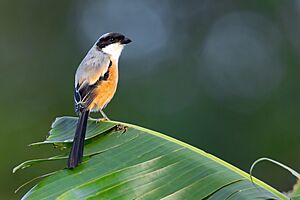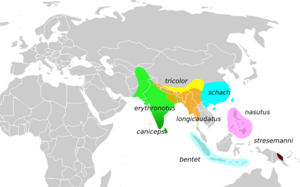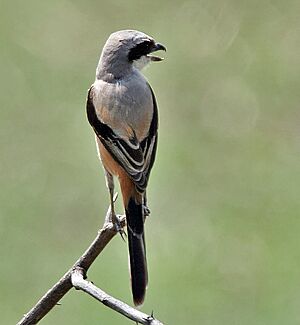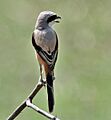Long-tailed shrike facts for kids
Quick facts for kids Long-tailed shrike |
|
|---|---|
 |
|
| Long tailed shrike in Sumatra, Indonesia | |
| Conservation status | |
| Scientific classification | |
| Genus: |
Lanius
|
| Species: |
schach
|
| Subspecies | |
|
|
 |
|
| Rough distribution of key forms | |
The long-tailed shrike (Lanius schach) is a cool bird from the shrike family. You might also hear it called the rufous-backed shrike. These birds live all over Asia, from the mainland to the islands in the east.
Even though they live in many different places, they all share some features. They have a long, thin black tail, a black mask over their eyes, and a bit of white on their shoulders. Their back and sides often have a reddish-brown (rufous) color. One type, found near the Himalayas, is sometimes called the black-headed shrike.
Contents
About the Long-tailed Shrike
The long-tailed shrike is a typical shrike. It likes dry, open areas. You can often spot it sitting on top of a bush or a wire. It has a dark mask that goes across its eyes. In some types, this mask covers the whole forehead. For example, the tricolor and nasutus shrikes have a completely black head.
Its tail is long and narrow. The outer feathers are a light reddish-brown. The erythronotus shrike has a grey back that blends into reddish-brown. The caniceps shrike from southern India has a pure grey back. Both male and female shrikes look similar.
Where Long-tailed Shrikes Live
These birds live across a huge area in Asia, from Kazakhstan all the way to New Guinea. They prefer places with bushes, grasslands, and open fields.
Many shrikes that live in cooler areas move south for winter. But those in warmer, tropical places usually stay put. The caniceps shrike in southern India spends winters in dry coastal areas. The tricolor shrike moves south to Bengal, India. You can often see them perched on wires along roads.
Sometimes, a long-tailed shrike might fly far off course. This is called being a "vagrant." There have been a few rare sightings in places like Great Britain and the Netherlands.
Shrike Behavior and Hunting
Long-tailed shrikes often sit upright on a perch. From there, they glide down to catch their food. They eat things like lizards, big insects, small birds, and rodents. They usually hunt alone or in pairs. Each pair has its own hunting area.
These birds make harsh, scolding calls. Some people say their calls sound like a frog squealing when a snake catches it! But they can also copy the sounds of other animals. They might include calls from lapwings, cuckoos, puppies, and even squirrels in their songs. Because they are such good singers, some people in Southeast Asia keep them as pets.
Shrikes are clever hunters. They sometimes catch fish from streams. They also eat small snakes. They might even steal food from other birds! They can catch flying insects in the air. Sometimes, they will stick their prey onto a thorny bush. This is why they are sometimes called "butcher birds." They might only eat the head or brain of their prey. They have even been seen trying to stick neem fruits onto twigs!
Reproduction and Life Cycle
Long-tailed shrikes usually breed in the summer in cooler regions. They build a deep, messy nest from thorny twigs, cloth, and hair. They place their nests in thorny bushes or trees.
A female shrike usually lays about 3 to 6 eggs. Both parents take turns sitting on the eggs to keep them warm. The eggs hatch after about 13 to 16 days. The parents feed their young chicks small pieces of birds they have caught. Sometimes, they will raise a second group of chicks in the same nest.
Sometimes, other birds called cuckoos lay their eggs in shrike nests. This is called brood parasitism. The shrike parents then raise the cuckoo chicks, thinking they are their own.
Images for kids
-
Upright posture (ssp. erythronotus (Keoladeo National Park, India))






